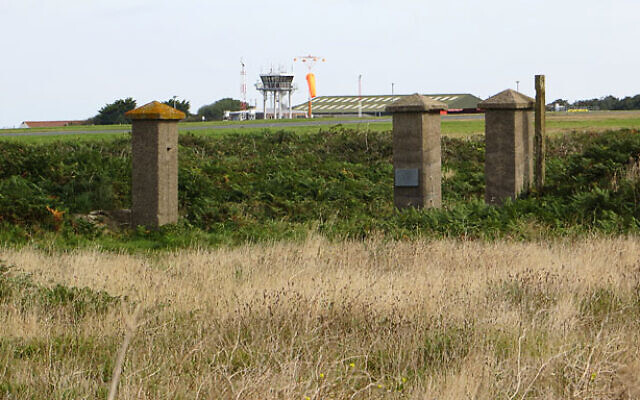New research raises death toll on island which housed the only concentration camp on British soil, and uncovers why perpetrators escaped justice.
By ROBERT PHILPOT, Times of Israel, June 20, 2024. Click for full report.
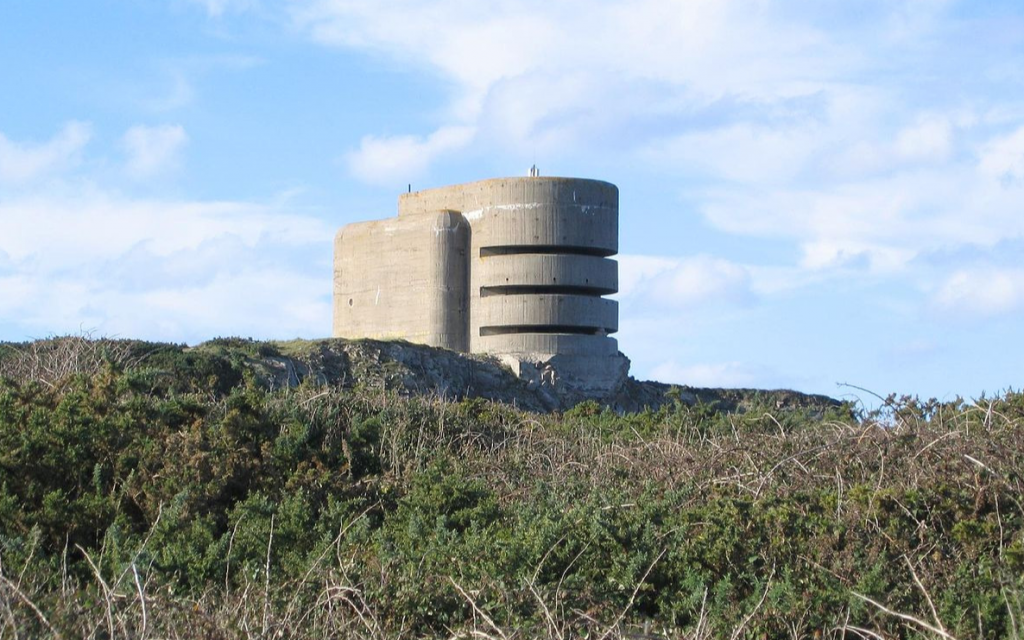
Illustrative: German WWII bunker ‘The Odeon’ in Alderney. The bunker is about three to four stories high and has an anti-aircraft emplacement at the back. (CC-SA-Tim Brighton)
LONDON — For the past decade, a fierce, increasingly rancorous, debate has been waged over the grim wartime past of the island of Alderney, which housed the only Nazi concentration camp to have existed on British soil.
Nobody disagrees that “le rocher maudit” – the accursed rock as French Jews dubbed it – was the scene of horrendous suffering during World War II as the Nazis shipped slave labor from across Europe to construct their “Atlantic Wall” fortifications.
But was the island truly a “Mini Auschwitz” where more than 40,000 perished – and did Britain launch a postwar cover-up over its failure to prosecute the perpetrators?
An inquiry commissioned by the British government into the allegations concluded last month that there is “no evidence for arguing that many thousands of victims died,” arguing: “Claims that Alderney constituted a ‘mini-Auschwitz’ are wholly unsubstantiated.”
The painstaking review of the mortality rates by international experts found the number of deaths in Alderney is likely to have ranged between 641 and 1,027 and is unlikely to have exceeded 1,134 people. The official number of people believed to have died during the Nazi occupation, calculated after Alderney’s liberation in May 1945, had stood at 389.
The report “should be seen as the definitive final word,” Dr. Gilly Carr, a leading Cambridge historian and authority on the Channel Islands, told The Times of Israel.

Channel Islands occupation expert Dr. Gillian Carr. (Courtesy)
Carr was one of 13 independent and internationally recognized experts asked last summer to conduct the review by the UK’s Holocaust Envoy, Lord Eric Pickles.
The review, whose findings have been welcomed by the United Kingdom’s Chief Rabbi, Sir Ephraim Mirvis, also throws light on the Nazis’ treatment of west European Jews who were married to “Aryan” women. Four of the 594 French Jews sent to Alderney are believed to have died on the island.
And it suggests a potentially intriguing link between Britain’s failure to bring those responsible for atrocities on the island to justice and the UK’s desire to get its hands on Gestapo officers accused of murdering 50 British servicemen who had attempted to escape from the Stalag Luft III prison camp in March 1944. The POWs’ heroism was later immortalized in the film “The Great Escape.”
Launchpad for the feared Western Front
Alderney is one of a small cluster of islands — an archipelago including Jersey, Guernsey, and Sark — that lie in the English Channel off the coast of Normandy. Semi-independent, they were nonetheless the only part of the British Isles to be occupied by the Nazis.
Three miles long and one-and-a-half miles wide, almost all of Alderney’s tiny civilian population was evacuated by Britain after the fall of France in June 1940.

A map of the English Channel. The island of Alderney lies just northwest of the coast of France, near Cherbourg. (Public domain)
From early 1942, Hitler ordered the construction of tunnels, bunkers, gun emplacements and artillery batteries designed to help protect the sea channels around Cherbourg, provide the Luftwaffe with anti-aircraft cover and deny the Allies a potentially useful staging post for the opening of the feared Western Front.
As a result of the order, the island became one of the most heavily defended, impregnable outposts of the Third Reich.
The price was paid by a legion of slave laborers from more than 30 countries – including French Jews, German political prisoners, Soviet POWs and anti-Franco Spanish republicans – who were assigned to four principal camps: Helgoland, Borkum, Norderney and Sylt. Originally one of the smaller camps, Sylt was later taken over by the SS and became a satellite of the Hamburg-based Neuengamme concentration camp.
The experts believe that the minimum number of prisoners or laborers sent to Alderney throughout the German occupation stands between 7,608 and 7,812 people.
The review underlines the brutal conditions endured by the Nazis’ prisoners on the island. “From 1940 until Liberation, for most of those sent to the island, Alderney was hell on earth,” Pickles, a former Conservative cabinet minister, writes in his introduction. “Prisoners were treated appallingly, and life was cheap.”

Eric Pickles speaks at a Conservative Friends of Israel event. (Conservative Friends of Israel)
The report terms the island’s slave labor operation “a microcosm of brutality” and details how laborers faced starvation, beatings, maiming and torture, and, “in some cases,” execution. Subjected to long working hours. and forced to complete dangerous construction works, they were housed in inadequate accommodation.
Who was imprisoned at Alderney?
As well as seeking to probe the numbers of individuals who passed through the Alderney camps, the review also sought to establish the identity of many who were previously unidentified. A master database, to which names are being added on a rolling basis, will eventually be made accessible to the general public.
Among the victims the report names are Leib Becker, who was Jewish and, at 66, is thought to be the oldest worker deployed by the Organization Todt, the Reich’s multi-tentacled civil and military engineering group, to die in Alderney. Based on the available information, the review suggests Stanislaus Knapp was the youngest prisoner to die; he was 15 when he died on September 14, 1942, reportedly from cachexia and heart weakness.
The youngest of the SS laborers to die were Mikhail Kanunenko (possibly Skanunenko), Volodymr Kotopulenko and Jakov Dovgaliuk, all of whom were 18 and most likely from Ukraine. The average age at death of SS laborers was 25.

A photo of the Sylt concentration camp on the island of Alderney after the Nazi surrender, May 1945. (Courtesy of the Trustees of the Royal Air Force Museum/ via Antiquity Publications)
The majority of victims, says the report, were civilians and prisoners of war from Russia, Ukraine, Belarus and Georgia. “As Eastern Europeans were seen by the Germans as inferior and as a threat to society, they were subject to very harsh treatment,” the report notes.
The review names a number of mass graves and burial sites on the island and, while recognizing that the Nazis dumped some bodies at sea “on a few occasions” suggests that the practice was not “widely used.”
The report assesses that the Third Reich’s notorious “extermination through labor” policy was not practiced on the island.
“There was an implicit understanding — in the OT, military and other German quarters in Alderney — that the deaths of large numbers of Eastern Europeans due to grueling working conditions were not a problem,” the experts suggest. “Nevertheless, this is different from deliberately planning to kill as many Eastern European forced laborers as possible through work.”
Not an extermination camp
It also dismisses talk of Alderney being a “mini-Auschwitz” where tens of thousands of prisoners died.
“There was no extermination centre on the Island,” writes Pickles. “Anyone who claims so has never visited Auschwitz or understood the extent of the Nazis’ death factories in Eastern Europe.”
The Holocaust envoy adds: “Numbers do matter. It is as much of a Holocaust distortion to exaggerate the number of deaths as it is to underplay the numbers. Exaggeration plays into the hands of Holocaust deniers and undermines the six million dead. The truth can never harm us.”
Pickles also sharply rebukes the tenor of the debate over what occurred on Alderney. “As the UK’s Special Envoy on Post Holocaust Issues, I have encountered many arguments over numbers,” he writes. “Nothing compares to the virulence or personal nature of arguments over numbers in Alderney.”
Case closed?
The old gate posts to the Sylt concentration camp on the island of Alderney, 2012. (CC BY-SA 2.0/ John Rostron)
Carr believes the expertise of those appointed to the panel should bring the debate to a close.
“I calculated that the team has between them several hundred year’s worth of experience in this field,” she says. “The team… have had as [our] goal to work for the truth and not to distort it in any way.” Panel members brought different specialist expertise from various countries. She likens their work on the project to assembling “a massive jigsaw.”
Carr continues: “All I can observe is that some of those who hold other theories do not have the same training or experience or qualifications and might be self-taught. I don’t think that other parties necessarily approach it with malign intentions. I think they probably sincerely believe in the theories that they hold.”
Carr, whose mother and husband are from Guernsey and who has written seven books on various aspects of the Nazi occupation of the Channel Islands, also notes the pitfalls of lacking the academic training required to assess what really happened on Alderney.
“Not all archives are equal, not all testimonies are equal,” she suggests. “You have to be critical about your sources.”
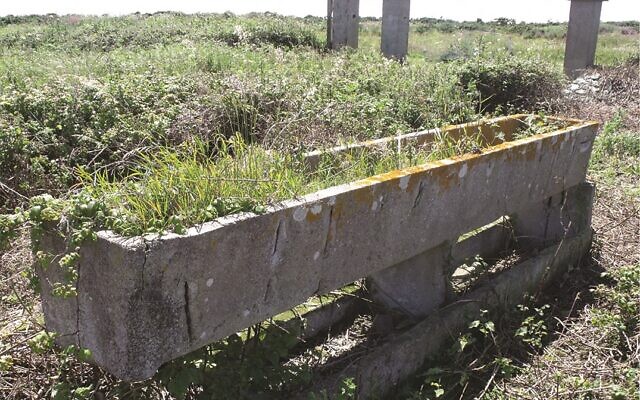
A stable block at the Sylt concentration camp on the island of Alderney. (Centre of Archaeology, Staffordshire University/ via Antiquity Publications)
Carr believes one of the most interesting aspects of the report is the further evidence it provides on the manner in which French Jews who were married to non-Jews were treated.
As the report details, the majority of the French Jewish contingent deported to Alderney in August and October 1943 had passed through the Drancy and Loiret internment camps and were the spouses of “Aryan” women. Technically, their marital status made them “non-deportable” to the extermination camps of the East, but they could be deported to forced labor camps. Sixty young French Jews who were not spouses of non-Jews were also sent to the island under the terms of the compulsory labor draft.
“The mortality rate of this group of deportees from France was low,” suggests Benoit Luc, director of the Service Départemental de l’Office National des Combattants et Victimes de Guerre de Loire-Atlantique, in his research for the review. “Although the Jews were subject to beatings and other forms of ill-treatment, there is no mention of summary executions or beatings resulting in death — neither in individual archives nor in direct testimony.”
The report also assesses the likelihood that any French Jews deported to Alderney remaining unaccounted for as “very small.” “Only individuals who had not come to the attention of their co-detainees –- a rather unlikely scenario –- could have remained unaccounted for,” it argues.
The Alderney Jewish mortality rate is also consistent with that in camps for Jewish forced labor elsewhere in western Europe and the German Reich. These were mainly used for Jewish “Mischlinge” – those the Nazis deemed to be of “mixed race” – and Jewish people married to non-Jews. Research into these camps indicates there was generally no mass murder and relatively few inmates died. (As the report notes, the situation in Eastern Europe – where no distinction between different groups of Jewish people was made – was “dramatically different.”)
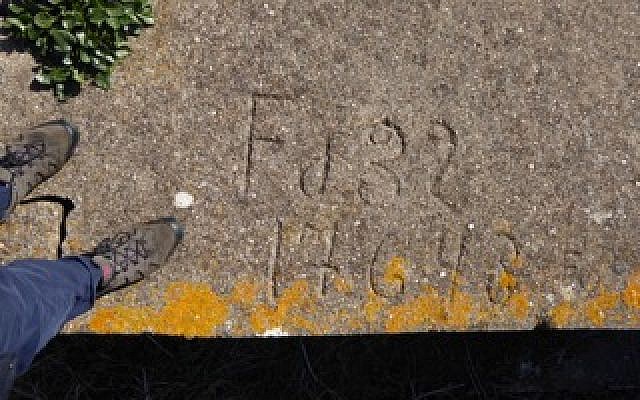
Graffiti on the top of an anti-tank wall on the British island of Alderney. (Marcus Roberts)
Dr. Henri Uzan, a Jewish survivor of Alderney quoted by Luc, also attributed the low mortality rate to three factors: high levels of solidarity within the group; the Channel Islands’ relatively benign climate (compared to Central and Eastern Europe); and the morale of these assimilated Frenchmen being boosted by being able to see their homeland on clear days.
Crucially, however, many of the more elderly members of the French Jewish contingent were transferred back to France in medical convoys in early 1944. Poor nutrition during their short stay on the island had left many infirm and thus unable to work. The SS commanders of the Norderney camp were convinced by a naval doctor to repatriate the sick men. Without this decision – one taken, the review notes, not out of altruism but of necessity – there would have been many more deaths. Moreover, while the Germans could have sent the men to Drancy, the Union Générale des Israëlites de France arranged for them to be sent to the Rothschild hospital in Paris. All but two of the 150 men placed on the medical convoys survived to see the liberation of Paris in August 1944.
The Great Escape… from justice
Alderney may not have been a “mini-Auschwitz,” but the death toll and poor treatment of prisoners surely demanded the war criminals responsible should face justice.
The review praises the initial investigation carried out on Alderney by the British military intelligence interrogator Cpt. Theodore “Bunny” Pantcheff. His team was “totally committed to gathering, at speed, prima facie evidence that would form the basis of an Alderney war crimes trial,” the report argues.
But, as Pickles argues, the fact that “the Nazi murderers on Alderney” never appeared before a British court is “a stain on the reputations of successive British governments.”
Research conducted by Prof. Anthony Glees, a leading academic who was appointed to advise the UK’s War Crimes Inquiry in the late 1980s, finds that Britain had no desire to see Nazi war criminals – many of whom it had in captivity – escape justice.
However, the authorities opted to secretly hand the case over to the Soviets almost as soon as the war ended – and then covered up what they had done.
The decision was made despite the fact that the Allies had decided that – except for the case of leading Nazis – war criminals should be tried and punished in the territories where their atrocities had been committed.
Instead, the Foreign Office and government lawyers decided in the summer of 1945 that all the evidence that had been meticulously gathered by Pantcheff in the “Alderney Case” should be turned over to the USSR on the basis that most of the victims were Soviets.
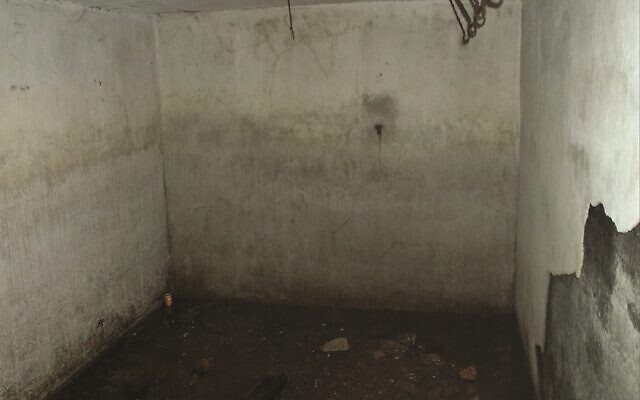
The prisoner kitchen cellar at the Sylt concentration camp on the island of Alderney. (Centre of Archaeology, Staffordshire University/via Antiquity Publications)
The UK pushed the Soviets throughout 1945 and 1946 to pursue the case and leading members of the government, including Foreign Secretary Ernest Bevin, considered trying the accused in the British Zone of Germany.
But the Soviets opted not to act – a fact the British authorities then chose to conceal from the public. Worse still, when France asked the UK in 1947 for any evidence it held about what had happened in Alderney for its own war crimes trials, Britain denied its existence.
Glees believes the reasons behind Britain’s “scarcely understandable” actions may lie in a 1945 memo between government lawyers. It suggested that, were the Soviets to accept the Alderney case, a “useful precedent” would be set that both “the nationality of the victims as well as the geographical location of the crimes should be a determining factor in deciding who should try a given war criminal.” This might encourage the Soviets to “give us more spontaneous help in other cases, particularly the Stalag Luft III case.” By 1945, the Gestapo men who, on Hitler’s orders, had shot the 50 British servicemen after the mass break-out from the prison camp were in Soviet hands.
The British ploy appeared to work. In 1947, a British military tribunal sitting in Hamburg, a city then in the Soviet zone of Germany, tried – and executed – a number of those responsible for the atrocity.
Justice may now be too late but what can be said of Alderney’s place in the story of the Holocaust?
The Holocaust, the review concludes, “is part of Alderney’s history.” There may have been no gas chambers or mass murders of Jews, but around 600 Jews were deported, imprisoned and used as slave labor for no reason other than that they were Jewish.
“In the eyes of the Nazi regime, Jewish forced labourers only had the right to live as long as their labour could be exploited,” the report suggests.
At the same time, however, the review argues that this slice of Holocaust history offers a “difficult and unfamiliar representation.” Most of the Jews transported to Alderney were there precisely because the Nazis had opted not to deport them to the East.
“While the German policy known as the Final Solution of the Jewish Question was the direct cause of their presence in Alderney,” it argues, “they were there because their destiny was to be an exception to that Final Solution, at least for the time being.”

